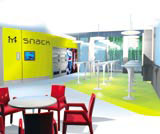Classroom makeover
Can ambitious Government plans to bring students, teachers and designers into the design process improve the image of schools?

Designing effective 21st century schools ‘has to be a two-way thing’, he adds. ‘Designers need to understand how schools work – the constraints of a school day, for example – and accept they’re not as outward-facing as the private sector. And schools need to know more about innovation and what’s possible. They need better information about what is available and help in managing design.’
Designers must also ensure they involve a broad audience in every project – children, teachers, governors and parents – and implement a rigorous process of consultation and engagement, says Greany.
‘Designers need to push to involve staff and students to identify issues and create a vision, even if the client isn’t requesting it,’ he adds.
The experience of one head teacher, Sarah Davey from Mounts Bay School and Community Sports College in Penzance, Cornwall, supports this view. Before taking part in the Sorrell Foundation’s programme, she had not thought about involving students in design projects.
‘We completed a new-build project shortly before [Joinedupdesignforschools] and didn’t involve students. But we’ve realised that students really can add creativity and the project is more likely to be successful and accessible if they’re involved,’ Davey explains.
In Sorrell’s project the client teams were students. They wrote the brief, worked with the designer and chose the solution in conjunction with head teachers. ‘Children are the consumers of education,’ says Sorrell. ‘You’re designing with students, not to them, and they must be a key part of the process.’
Davey adds: ‘I was surprised at how much creativity was hidden within students. Given the opportunity to think more flexibly they were excited, engaged and came up with marvellous ideas. This project has helped to create a culture change at the school and it has given the student voice a much bigger profile.’
According to ArthursteenAdamson partner Marksteen Adamson, designers also need to realise ‘that working in the sector is not about ideas and design concepts for portfolios; it is about making great schools for our children’.
The group recently completed two identity projects as part of the Sorrell Foundation scheme. Adamson says, ‘If ideas aren’t practical all you’ll end up with is a new letterhead, which doesn’t really achieve very much.’
He says the Government’s focus on capital improvements is a much needed boost. In the past design has been perceived as a vanity spend compared to more core requirements.
‘Most head teachers operate with incredibly tight budgets and it’s totally valid that supply teachers, computers and books are a priority, they are the [necessities]’, agrees Adamson. ‘But if you compare the other environments that children use, from home to cinema and shopping, schools are dingy in comparison. Going to school should be a home-to-home, not a home-to-institution experience.
‘We have an expectation in Britain that public services are grim. We need to catch up with the rest of Europe and realise that need not be the case,’ he adds.
There is recognition across Government, the education sector and the design industry that it’s time our schools joined the 21st century. However, throwing money at the problem is not enough. There are real cultural changes that need to be wrought within the education sector – and within design too – if schools are to become 21st century flagships rather than just a repeat of existing designs and their associated problems.
Joinedupdesignforschools, by John and Frances Sorrell is published on 21 February by Merrell Publishers, price £29.95 hardback. The Joinedupdesignforschools exhibition takes place from 21 February-18 March at the Victoria & Albert Museum, London SW7
The Design Council hosts From the Inside Looking Out, a conference on innovation in school learning environments, on 17 March at the Hilton Metropole Hotel Birmingham. It will also publish a booklet on the subject in late February
Audi Foundation Innovation Awards
The dependence on stock computer design in education is the target of a new awards scheme from the Audi Design Foundation. It is seeking to develop creativity in schools, particularly the new curricular subject of Design and Technology, by offering cash prizes and teaching support. Secondary schools will be invited to cater their proposals to a set of six design challenges. The initiative was developed by a panel of teachers and is aimed at 11- to 14-year-olds.
The scheme has the support of psychologist Dr Aric Sigman, who says: ‘In our logo-centric culture, TV images and the over-reliance on computer graphics is leading to a creative dumbing-down in children. Thinking in a linear fashion, over-use of technology in the early design stages, being exposed to pre-fab design ‘rules’ – rather than taking creative leaps and risks – is threatening to displace much of the intuitive, spontaneous creativity inherent in our children.
The winner of the scheme is scheduled to be announced in April.
-
Post a comment



